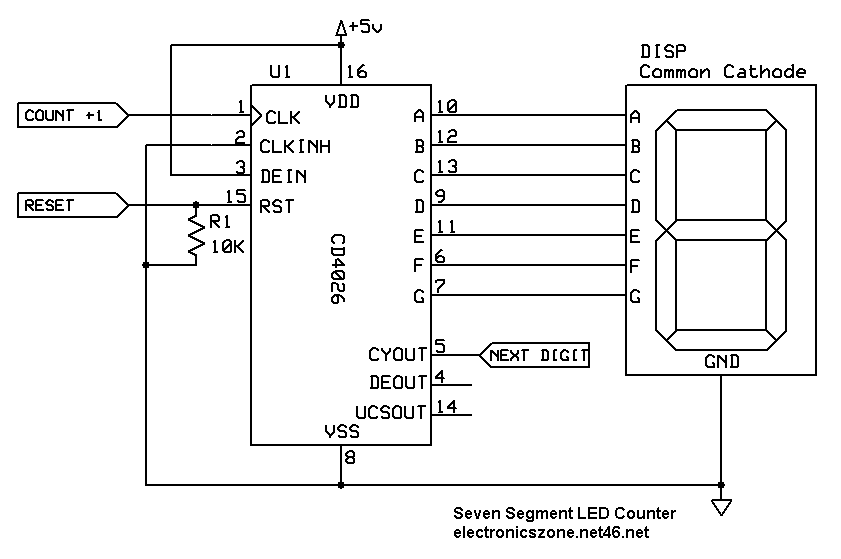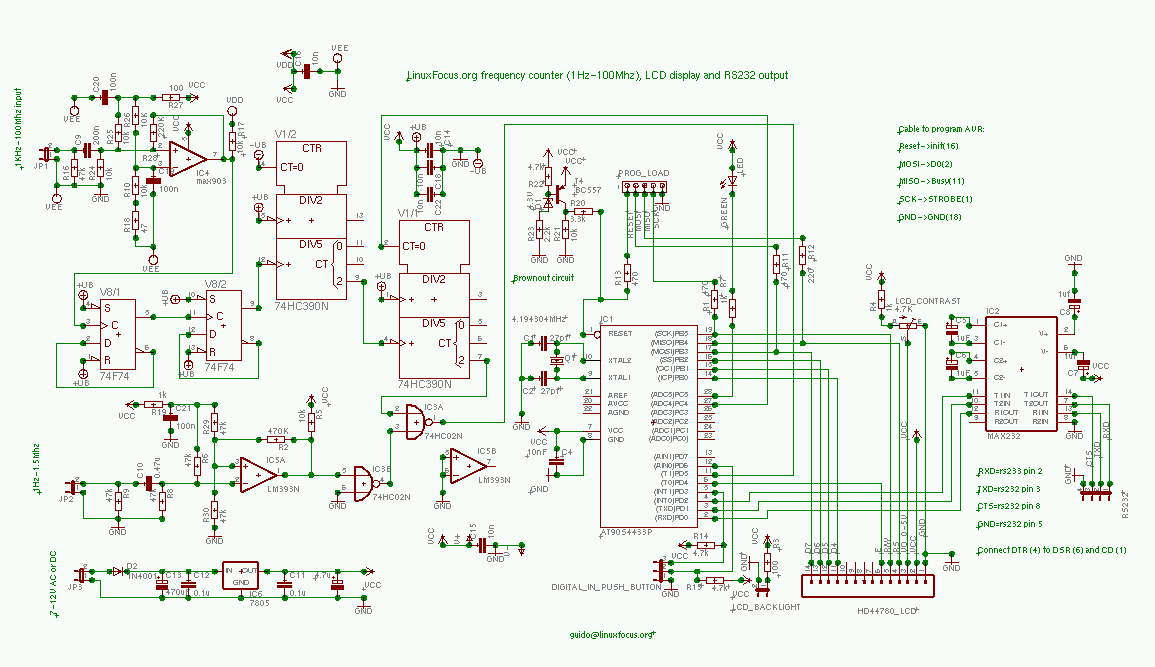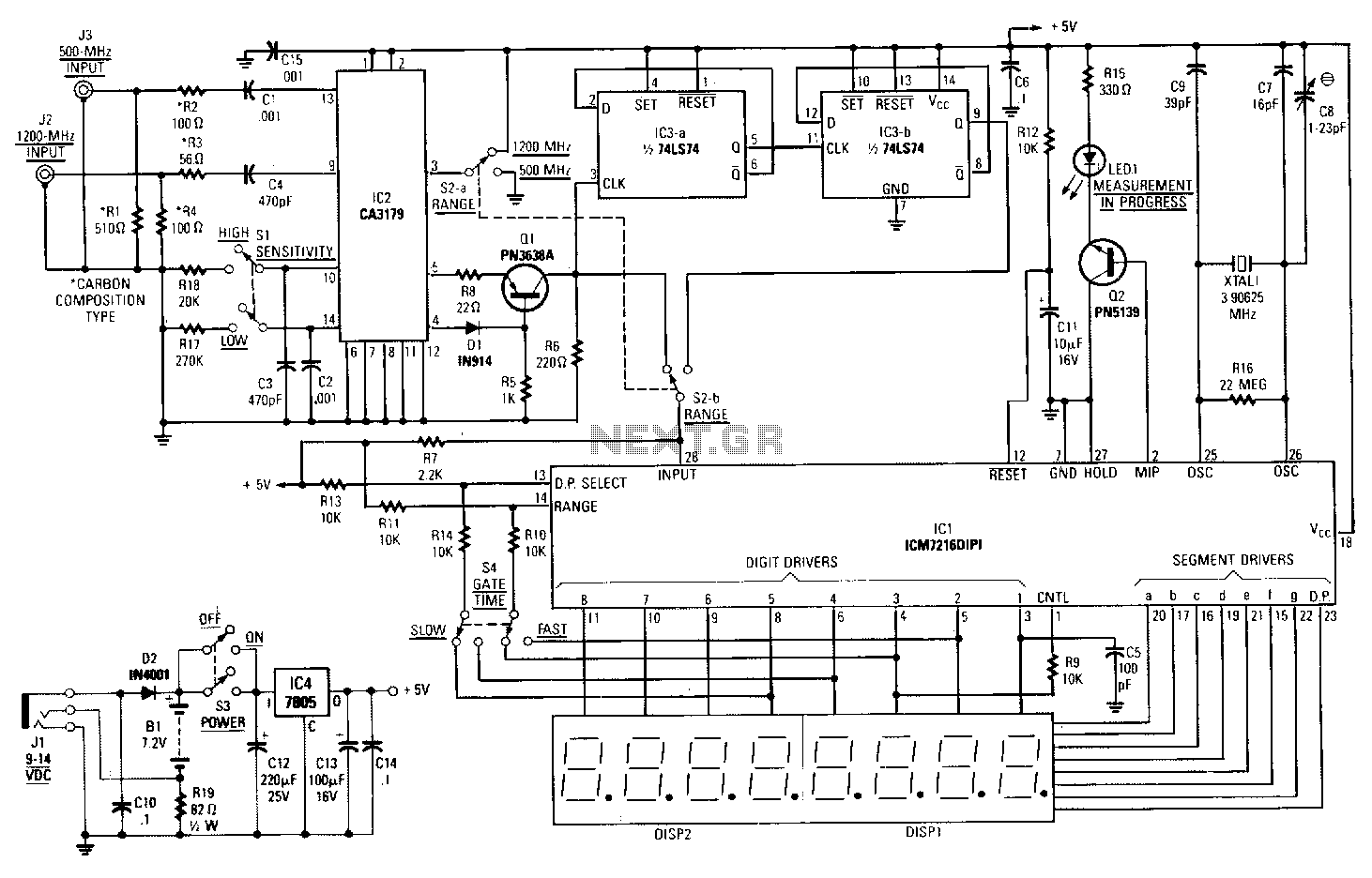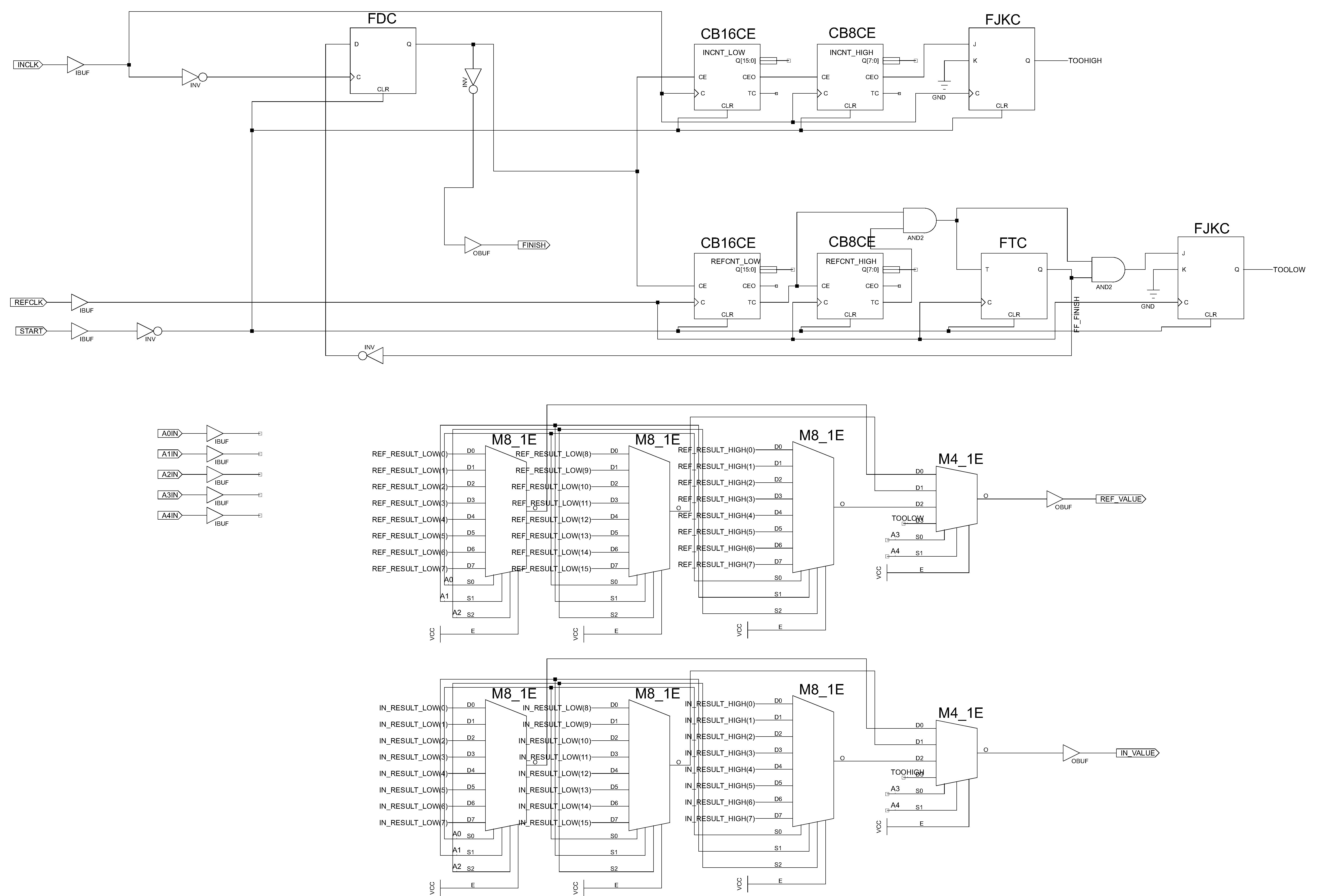
Geiger Counter
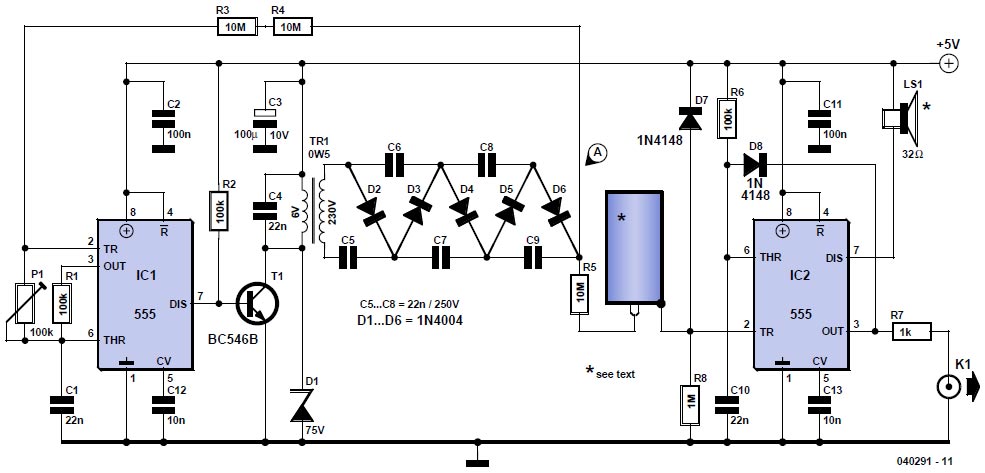
April 2006 marked the twentieth anniversary of the Chernobyl reactor accident. In the aftermath of the incident, winds dispersed much of the reactor's contents across central Europe, Scandinavia, and the UK. A large area surrounding the reactor remains restricted, raising concerns about the extent of fallout still present in gardens and farmlands. At the time of the release, Iodine-131 was responsible for numerous cases of thyroid cancer; however, with a half-life of 8.1 days, it does not pose a significant long-term threat. Strontium-90 presents a greater challenge due to its half-life of 28 years, with over 50% of the fallout still remaining. Radioactive cesium impacts the food chain and can contaminate milk, meat, and, to a lesser extent, crops. Since radioactivity is invisible, a detector is necessary for measuring it; the most common and simplest type is the Geiger counter. The design described here utilizes two NE555 timer integrated circuits (ICs), a small mains transformer, and several standard components to create a low-cost and easy-to-assemble Geiger counter. The primary challenge lies in sourcing a Geiger-Müller (GM) tube, which is not a standard component. Online auction sites like eBay may offer new or used counter tubes, and alternative sources can be identified through Google. A brand new ZP1300 tube is available from ALRAD for £55.00 plus VAT, categorized under nuclear products and nucleonics. The GM tube requires a high voltage of approximately 700 V. IC1 is a NE555 timer configured as an astable multivibrator, which drives a BC547C transistor that, in turn, energizes the secondary winding of a 6 V mains transformer. This setup generates an alternating voltage of around 250 V at the primary side, which is then increased through a classic voltage multiplier configuration consisting of cascaded capacitors and diodes to produce approximately 700 V DC. The voltage is fed back to the timer input through resistors R3 and R4 to stabilize the output voltage. The counter tube anode connects to 700 V via a 10 MΩ protection resistor. Under normal conditions, with no radiation detected, there is no current flowing through the tube and gas filling. When a radiation source approaches the tube, ionizing radiation passes through and interacts with gas atoms, knocking some electrons out of their shells. This interaction generates a current pulse from the tube terminal, which produces a voltage pulse across a 1 MΩ resistor that is sufficient to trigger IC2. The NE555 amplifies this pulse, creating the characteristic tick-tick sound of a Geiger counter from speaker LS1. An external pulse counter can be connected to K1. A copy of an original Philips Geiger tube data sheet is available at ehler/18550.pdf. Philips tubes are currently manufactured by Centronic, which provides a useful Geiger selection guide on their website.
The described Geiger counter circuit is an effective solution for detecting ionizing radiation in a cost-efficient manner. The use of NE555 timer ICs allows for precise timing and control of the voltage levels required for the operation of the GM tube. The configuration of the astable multivibrator ensures that the circuit can generate the necessary high voltage reliably. The voltage multiplier circuit, composed of capacitors and diodes, efficiently converts the lower voltage output from the transformer into the high voltage needed for the GM tube operation.
The inclusion of protection resistors ensures the safety and longevity of the GM tube by limiting the current that can flow through it. The feedback mechanism from the output voltage back to the timer input helps maintain consistent performance, enhancing the stability of the Geiger counter. The audible feedback provided by the speaker allows users to easily monitor radiation levels, making it a practical tool for both hobbyists and professionals in fields such as environmental monitoring, nuclear safety, and health physics.
In conclusion, this Geiger counter design serves as a practical and educational project for those interested in radiation detection, providing insights into the principles of electronics, high voltage generation, and the interaction of radiation with matter. The availability of components, particularly the GM tube, remains a critical factor in the feasibility of constructing this device.April 2006 was the twentieth anniversary of the Chernobyl reactor accident. In the days following the incident winds deposited much of the reactor contents across central Europe, Scandinavia and the UK. A large area surrounding the reactor is still off limits but just how much of the fallout is still lying around on our gardens and farmlands At t
he time of the release Iodine 131 was responsible for many cases of thyroid cancer but with a half life of 8. 1 days this does not pose much of a threat in the long term. Strontium 90 is more of a problem; it has a half life of 28 years and more than 50 % of the fallout still remains.
Radio caesium affects the food chain and can contaminate milk, meat and to a lesser extent crops. Radioactivity is invisible so a detector is needed before we can start to make any measurements; the most common and simplest detector type is the Geiger counter. The design described here uses two NE555 type timer ICs, a small mains transformer and a few other standard components to make a low cost and simple to build Geiger counter.
The only fly in the ointment is likely to be locating a Geiger-Mueller (GM) tube; this is not in any way a standard component. The on-line auction site eBay may provide a source of new or used counter tubes or alternatively Google will be useful in identify stockists.
A brand new type ZP1300 tube can be purchased from ALRAD ( ) at a cost of £55. 00 plus VAT. The GM tubes are listed under nuclear products and nucleonics. The counter tube requires a high voltage in the region of 700 V. IC1 is a NE555 timer configured as an astable multivibrator switching the BC547C transistor which in turn drives the secondary winding of a 6 V mains transformer. An alternating voltage of around 250 V is produced at the primary side which is then multiplied by the classic voltage multiplier configuration consisting of cascaded capacitors and diodes to produce around 700 V DC.
The voltage is fed back to the timer input through resistors R3 and R4 to provide some stability of the output voltage. The counter tube anode is connected to 700 V via a 10 M © protection resistor. In normal operation with no radiation detected there will be no current flowing through the tube and gas filling.
When a radiation source is brought close to the tube, ionising radioactive rays pass through it and collide with some gas atoms knocking a few electrons out of their shell; this produces a current pulse from the tube terminal which in turn generates a voltage pulse across the 1 M © resistor high enough to trigger IC2. The NE555 effectively amplifies the pulse to produce the familiar tick-tick sound of a Geiger counter from the speaker LS1.
An external pulse counter can be connected to K1. A copy of an original Philips Geiger tube data sheet is available at ehler/18550. pdf. Philips tubes are now made by Centronic ( ) and their site contains a useful Geiger selection guide. 🔗 External reference
The described Geiger counter circuit is an effective solution for detecting ionizing radiation in a cost-efficient manner. The use of NE555 timer ICs allows for precise timing and control of the voltage levels required for the operation of the GM tube. The configuration of the astable multivibrator ensures that the circuit can generate the necessary high voltage reliably. The voltage multiplier circuit, composed of capacitors and diodes, efficiently converts the lower voltage output from the transformer into the high voltage needed for the GM tube operation.
The inclusion of protection resistors ensures the safety and longevity of the GM tube by limiting the current that can flow through it. The feedback mechanism from the output voltage back to the timer input helps maintain consistent performance, enhancing the stability of the Geiger counter. The audible feedback provided by the speaker allows users to easily monitor radiation levels, making it a practical tool for both hobbyists and professionals in fields such as environmental monitoring, nuclear safety, and health physics.
In conclusion, this Geiger counter design serves as a practical and educational project for those interested in radiation detection, providing insights into the principles of electronics, high voltage generation, and the interaction of radiation with matter. The availability of components, particularly the GM tube, remains a critical factor in the feasibility of constructing this device.April 2006 was the twentieth anniversary of the Chernobyl reactor accident. In the days following the incident winds deposited much of the reactor contents across central Europe, Scandinavia and the UK. A large area surrounding the reactor is still off limits but just how much of the fallout is still lying around on our gardens and farmlands At t
he time of the release Iodine 131 was responsible for many cases of thyroid cancer but with a half life of 8. 1 days this does not pose much of a threat in the long term. Strontium 90 is more of a problem; it has a half life of 28 years and more than 50 % of the fallout still remains.
Radio caesium affects the food chain and can contaminate milk, meat and to a lesser extent crops. Radioactivity is invisible so a detector is needed before we can start to make any measurements; the most common and simplest detector type is the Geiger counter. The design described here uses two NE555 type timer ICs, a small mains transformer and a few other standard components to make a low cost and simple to build Geiger counter.
The only fly in the ointment is likely to be locating a Geiger-Mueller (GM) tube; this is not in any way a standard component. The on-line auction site eBay may provide a source of new or used counter tubes or alternatively Google will be useful in identify stockists.
A brand new type ZP1300 tube can be purchased from ALRAD ( ) at a cost of £55. 00 plus VAT. The GM tubes are listed under nuclear products and nucleonics. The counter tube requires a high voltage in the region of 700 V. IC1 is a NE555 timer configured as an astable multivibrator switching the BC547C transistor which in turn drives the secondary winding of a 6 V mains transformer. An alternating voltage of around 250 V is produced at the primary side which is then multiplied by the classic voltage multiplier configuration consisting of cascaded capacitors and diodes to produce around 700 V DC.
The voltage is fed back to the timer input through resistors R3 and R4 to provide some stability of the output voltage. The counter tube anode is connected to 700 V via a 10 M © protection resistor. In normal operation with no radiation detected there will be no current flowing through the tube and gas filling.
When a radiation source is brought close to the tube, ionising radioactive rays pass through it and collide with some gas atoms knocking a few electrons out of their shell; this produces a current pulse from the tube terminal which in turn generates a voltage pulse across the 1 M © resistor high enough to trigger IC2. The NE555 effectively amplifies the pulse to produce the familiar tick-tick sound of a Geiger counter from the speaker LS1.
An external pulse counter can be connected to K1. A copy of an original Philips Geiger tube data sheet is available at ehler/18550. pdf. Philips tubes are now made by Centronic ( ) and their site contains a useful Geiger selection guide. 🔗 External reference
